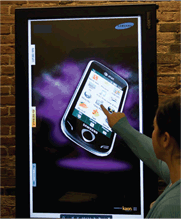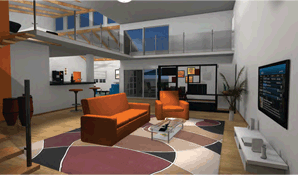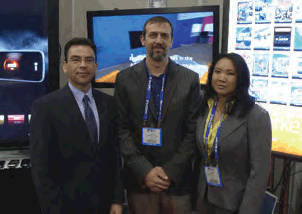Race to Innovation

Samsung and Rival Industries Think Outside the Box for Interactive Digital Signage
At the Digital Signage Expo (DSE), which wrapped February 25th in Las Vegas, Samsung showcased the top three finalists for their Race to Innovation contest. As one of the judges for the contest, I was on hand to assess the entries and help in selecting the winner.

Kaon’s interactive digital 3D product tour, one of the finalists in the contest, allows the mobile phone customer to experience the entire range of relevant products and options available to them using a 3D modeling of the handsets. The customer can also email themselves a PDF with imbedded 3D images.
The contest was very thorough in its execution — for a reason. Samsung, as a market leader of large format displays (LFD’s) for the digital signage display market, has been dealing with this relatively new industry’s challenges: budget challenges; the lack of a standard method for measurement; ambiguity about ROI; no standard technology platform; and a disparate ecosystem of networks. As LFD is a major focus for the company, Samsung was actively seeking methods to break through these challenges to stimulate growth in creative new ways.

The winning entry of the Race To Innovation contest: Rival Industries
“Virtual Home” created virtual home offices or, shown here, virtual
living rooms where a customer was able to create a complete personal
technology suite in their own virtual environment.
To create this growth around today’s challenges, two things were required: [1] an honest assessment of foundational causes of the challenges; and [2] simplicity in the potential solutions. Samsung realized that most digital signage systems were not rooted in solving brand and shopper challenges. Rather, they were created in a lab where technology led the development and the voice of the customer was not paramount. They found this approach to be backwards and began striving to promote products based on what their partners and customers needed to be successful.
Working with Atlanta-based Laura Davis Taylor and the team at Retail Media Consulting, beginning last spring, Samsung took this insight and turned it into action to help stimulate both their LFD product goals and the growth of digital signage in the retail industry in general. Looking for the cause of “real retail disease,” their research found that shoppers were still desperate for retailers to “make it easier” to shop the store, provide better customer service, and build better bridges between personalized online experiences and instore experiences. It was from these observations that Samsung’s “Race to Innovation” was born.
A daily selection of the top stories for AV integrators, resellers and consultants. Sign up below.

The finalists in the Race To Innovation contest: (left to right) Gavin A. Finn, Ph.D., president and CEO of Kaon Interactive; Jeff Weese, CEO of Rival Industries; and Grace Ou, COO, Rival Industries...
All the entries in the Samsung Race to Innovation contest showed creative use of technology to promote shopper engagement. Judging — which started last summer, was not easy. At DSE’s conclusion, Russell Young, senior manager, Strategic Alliances, Samsung Electronics America, announced the winner. Rival Industries was awarded the victory with their Virtual Home entry.
The other two finalists were another entry from Rival Industries — a unique iPhone-like screen that presented, on a large format vertically oriented LCD panel, touch-activated icons that controlled a game-formatted selection of products and services — and Kaon’s interactive digital 3D product tour that allowed the mobile phone customer to experience the entire range of relevant products and options available to them using a 3D modeling of the handsets on an LCD panel. A unique feature of this entry was that the customer could also email themselves a PDF with imbedded 3D images — transferring that 3D capability to the users’ own desktops was compelling.
Rival Industry’s winning Virtual Home/Office application stood out with its use of a “virtual tour” platform, where a customer could walk through virtual rooms and engage with 3D environmental elements while also getting phone and other personal technology demos. Particularly engaging were Rival’s placement of “easter eggs” — a term borrowed from gaming platforms — throughout the rooms, where the customer could find unexpected surprises in the form of interactive games, music, or new smartphone demos.
The AVNetwork staff are storytellers focused on the professional audiovisual and technology industry. Their mission is to keep readers up-to-date on the latest AV/IT industry and product news, emerging trends, and inspiring installations.
